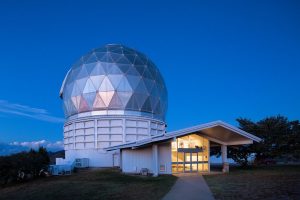
In the November issue of Scientific American, there is an article on the Dark Energy Survey, “Seeing in the Dark.” How is this survey similar to – or different – from HET-DEX (besides being in Chile instead of Ft Davis)?
As the Scientific American article states, the five-year Dark Energy Survey (DES) will cover 5000 square degrees of the southern sky in the optical and infrared, using four different probes of dark energy: Type Ia supernovae, baryonic acoustic oscillations (BAOs), weak lensing, and galaxy cluster counts. BAOs will be measured from the distribution of 200-300 million galaxies out to a redshift z ~ 1.3. DES is a photometric survey, which means that its primary instrument, DECam, uses filters to separate the different wavelengths of light and measure the relative intensity of each wavelength. More specifically, the charge-coupled devices (CCDs) comprising DECam effectively count the photons at each wavelength of light.
The Hobby Eberly Telescope Dark Energy eXperiment (HETDEX) is a three-year optical survey which will cover 420 square degrees of the northern sky. HETDEX is a spectroscopic survey, meaning our instruments give the spectrum of incident light. Furthermore, our spectrographs make use of integral field unit (IFU) technology, which actually lets us spatially resolve the spectra to get a 3D image. With HETDEX, we’re measuring BAOs using a specific type of very distant, star-forming galaxy known as a Lyman Alpha Emitter (LAE). At high redshifts, LAE spectra feature a single, distinctive emission line in the optical, making them very useful as probes of the early Universe. HETDEX will fit the full power-spectrum (which is a fancy way of saying that it will tell us not just about pure BAOs but also about how the growth rate of cosmic structures has changed, and how gravity behaves on cosmological scales) of ~1 million LAEs in the redshift range 1.9 < z < 3.5, allowing for a factor of two to three more accuracy than a typical BAO experiment. The result will be the largest map of the universe ever produced.
 In summary, the surveys are similar in that they both probe dark energy via BAOs with observations at optical wavelengths, but DES combines additional probes (supernovae, weak lensing, and galaxy cluster counts) with their BAO measurements and also includes observations in the infrared. DES and HETDEX are examining very different regions of the sky, and DES has a really wide field probing more recent epochs, whereas HETDEX has a really deep one probing the earlier Universe. Finally, their imaging methods are fundamentally different. All of these factors combine to make HETDEX and DES highly complementary surveys; despite their contrasting instrumentation, survey regions, and measurement methods, they are really probing the same fundamental question(s), and their results need to be consistent.
In summary, the surveys are similar in that they both probe dark energy via BAOs with observations at optical wavelengths, but DES combines additional probes (supernovae, weak lensing, and galaxy cluster counts) with their BAO measurements and also includes observations in the infrared. DES and HETDEX are examining very different regions of the sky, and DES has a really wide field probing more recent epochs, whereas HETDEX has a really deep one probing the earlier Universe. Finally, their imaging methods are fundamentally different. All of these factors combine to make HETDEX and DES highly complementary surveys; despite their contrasting instrumentation, survey regions, and measurement methods, they are really probing the same fundamental question(s), and their results need to be consistent.
You can read more about HETDEX on our website.
Rebecca Tippens
UT Austin